Neolithic
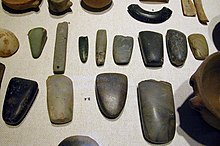
| The Neolithic |
|---|
| ↑ Mesolithic |
| ↓ Chalcolithic |
The Neolithic Age, Era, or Period, or New Stone Age, was a period in the development of human technology, beginning about 9500 BC in the Middle East[1] that is traditionally considered the last part of the Stone Age. The Neolithic followed the terminal Holocene Epipalaeolithic period, beginning with the rise of farming, which produced the "Neolithic Revolution" and ending when metal tools became widespread in the Copper Age (chalcolithic) or Bronze Age or developing directly into the Iron Age, depending on geographical region. The Neolithic is not a specific chronological period, but rather a suite of behavioral and cultural characteristics, including the use of wild and domestic crops and the use of domesticated animals.[2]
New findings put the beginning of the Neolithic culture back to around 10,700 to 9400 BC in Tell Qaramel in northern Syria, 25 km north of Aleppo.[3] Until those findings are adopted within the archaeological community, the beginning of the Neolithic culture is considered to be in the Levant (Jericho, modern-day West Bank) about 9500 BC. It developed directly from the Epipaleolithic Natufian culture in the region, whose people pioneered the use of wild cereals, which then evolved into true farming. The Natufians can thus be called "proto-Neolithic" (12,500–9500 BC or 12,000–9500 BC[1]). As the Natufians had become dependent on wild cereals in their diet, and a sedentary way of life had begun among them, the climatic changes associated with the Younger Dryas are thought to have forced people to develop farming. By 9500–9000 BC, farming communities arose in the Levant and spread to Asia Minor, North Africa and North Mesopotamia. Early Neolithic farming was limited to a narrow range of plants, both wild and domesticated, which included einkorn wheat, millet and spelt, and the keeping of dogs, sheep and goats. By about 8000 BC, it included domesticated cattle and pigs, the establishment of permanently or seasonally inhabited settlements, and the use of pottery.[4]
Not all of these cultural elements characteristic of the Neolithic appeared everywhere in the same order: the earliest farming societies in the Near East did not use pottery, and, in Britain, it remains unclear to what extent plants were domesticated in the earliest Neolithic, or even whether permanently settled communities existed. In other parts of the world, such as Africa, South Asia and Southeast Asia, independent domestication events led to their own regionally-distinctive Neolithic cultures that arose completely independent of those in Europe and Southwest Asia. Early Japanese societies used pottery before developing agriculture.[5][6][7]
Unlike the Paleolithic, where more than one human species existed, only one human species (Homo sapiens) reached the Neolithic. Homo floresiensis may have survived right up to the very dawn of the Neolithic, about 12,000 years ago.
The term Neolithic derives from the Greek νεολιθικός, neolithikos, from νέος neos, "new" + λίθος lithos, "stone", literally meaning "New Stone Age." The term was invented by Sir John Lubbock in 1865 as a refinement of the three-age system.
Periods by pottery phase
In Southwest Asia (i.e., the Middle East), cultures identified as Neolithic began appearing in the 10th millennium BC.[1] Early development occurred in the Levant (e.g., Pre-Pottery Neolithic A and Pre-Pottery Neolithic B) and from there spread eastwards and westwards. Neolithic cultures are also attested in southeastern Anatolia and northern Mesopotamia by c. 8000 BC.
The prehistoric Beifudi site near Yixian in Hebei Province, China, contains relics of a culture contemporaneous with the Cishan and Xinglongwa cultures of about 5000–6000 BC, neolithic cultures east of the Taihang Mountains, filling in an archaeological gap between the two Northern Chinese cultures. The total excavated area is more than 1,200 square meters and the collection of neolithic findings at the site consists of two phases.[8]
Neolithic 1 – Pre-Pottery Neolithic A (PPNA)
Recent findings made by a Syrian-Polish joint excavation team run by Prof. R.F. Mazurowski, in Tell Qaramel, 25 km to the north of Aleppo put the beginning of the Neolithic 1 (PPNA) around 10,700 to 9400 BC.[3] Previous excavations at that site brought the discovery of four circular towers dating back to between the eleventh millennium and about 9,650 BC [citation needed].
Until the findings in Tell Qaramel are adopted within the archaeological community, sites in the Levant (Jericho, Palestine & Jbeil (Byblos), Lebanon) that go back to around 9500 to 9000 BC. are still considered the beginning of the Neolithic 1 (PPNA). The actual date is not established with certainty due to different results in carbon dating by scientists in the British Museum and Philadelphia laboratories[citation needed].
An early temple area in southeastern Turkey at Göbekli Tepe dated to 10,000 BC may be regarded as the beginning of the Neolithic 1. This site was developed by nomadic hunter-gatherer tribes, evidenced by the lack of permanent housing in the vicinity. This temple site may be the oldest known man-made place of worship.[9] At least seven stone circles, covering 25 acres (100,000 m2), contain limestone pillars carved with animals, insects and birds. Stone tools were used by perhaps as many as hundreds of people to create the pillars, which may have supported roofs.
The major advance of Neolithic 1 was true farming. In the proto-Neolithic Natufian cultures, wild cereals were harvested, and perhaps early seed selection and re-seeding occurred. The grain was ground into flour. Emmer wheat was domesticated, and animals were herded and domesticated (animal husbandry and selective breeding).
In the 21st century, remains of figs were discovered in a house in Jericho dated to 9400 BC. The figs are of a mutant variety that cannot be pollinated by insects, and therefore the trees can only reproduce from cuttings. This evidence suggests that figs were the first cultivated crop and mark the invention of the technology of farming. This occurred centuries before the first cultivation of grains.[10]
Settlements became more permanent with circular houses, much like those of the Natufians, with single rooms. However, these houses were for the first time made of mudbrick. The husband had one house, while each of his wives lived with their children in surrounding houses.[citation needed] The settlement had a surrounding stone wall and perhaps a stone tower (as in Jericho). The wall served as protection from nearby groups, as protection from floods, or to keep animals penned. There are also some enclosures that suggest grain and meat storage.
Neolithic 2 – Pre-Pottery Neolithic B (PPNB)
The Neolithic 2 (PPNB) began around 8500 BC in the Levant (Jericho, Palestine).[1] As with the PPNA dates there are two versions from the same laboratories noted above. But this terminological structure is not convenient for southeast Anatolia and settlements of the middle Anatolia basin. This era was before the Mesolithic era.
Settlements have rectangular mudbrick houses where the family lived together in single or multiple rooms. Burial findings suggest an ancestor cult where people preserved skulls of the dead, which were plastered with mud to make facial features. The rest of the corpse may have been left outside the settlement to decay until only the bones were left, then the bones were buried inside the settlement underneath the floor or between houses.
Neolithic 3 – Pottery Neolithic (PN)
The Neolithic 3 (PN) began around 6500 BC in the Fertile Crescent.[1] By then distinctive cultures emerged, with pottery like the Halafian (Turkey, Syria, Northern Mesopotamia) and Ubaid (Southern Mesopotamia).
The Chalcolithic period began about 4500 BC, then the Bronze Age began about 3500 BC, replacing the Neolithic cultures.
Periods by region
Fertile Crescent
Around 9500 BC, the first fully developed Neolithic cultures belonging to the phase Pre-Pottery Neolithic A (PPNA) appeared in the fertile crescent.[1] Around 10,700 to 9400 BC, a settlement was established in Tell Qaramel, 25 kilometers north of Aleppo. The settlement included 2 temples dating back to 9650.[3] Around 9000 BC during the Pre-Pottery Neolithic A (PPNA), the world's first town, Jericho, appeared in the Levant. It was surrounded by a stone and marble wall and contained a population of 2000–3000 people and a massive stone tower.[11] Around 6000 BC the Halaf culture appeared in Lebanon, Israel and Palestine, Syria, Anatolia, and Northern Mesopotamia and subsisted on dryland agriculture.
Southern Mesopotamia
Alluvial plains (Sumer/Elam). Little rainfall makes irrigation systems necessary. Ubaid culture from 5500 BC.
North Africa
Domestication of sheep and goats reached Egypt from the Near East possibly as early as 6000 BC[citation needed]. Graeme Barker states "The first indisputable evidence for domestic plants and animals in the Nile valley is not until the early fifth millennium bc in northern Egypt and a thousand years later further south, in both cases as part of strategies that still relied heavily on fishing, hunting, and the gathering of wild plants" and suggests that these subsistence changes were not due to farmers migrating from the Near East but was an indigenous development, with cereals either indigenous or obtained through exchange.[12] Other scholars argue that the primary stimulus for agriculture and domesticated animals (as well as mud-brick architecture and other Neolithic cultural features) in Egypt was from the Middle East.[13][14][15]
Europe

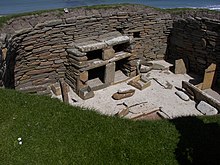
In southeast Europe agrarian societies first appeared by c. 7000 BC,[16] and in Central Europe by ca. 5500 BC. Among the earliest cultural complexes of this area are included the Sesklo culture in Thessaly , which later expanded in the Balkans giving Starčevo-Körös (Cris), Linearbandkeramic, and Vinča. Through a combination of cultural diffusion and migration of peoples, the Neolithic traditions spread west and northwards to reach northwestern Europe by around 4500 BC. The Vinča culture may have created the earliest system of writing, the Vinča signs, though it is almost universally accepted amongst archeologists[who?] that the Sumerian cuneiform script was the earliest true form of writing and the Vinča signs most likely represented pictograms and ideograms rather than a truly developed form of writing.[citation needed] The Cucuteni-Trypillian culture built enormous settlements in Romania, Moldova and Ukraine from 5300 to 2300 BC. The megalithic temple complexes of Ġgantija on the Mediterranean island of Gozo (in the Maltese archipelago) and of Mnajdra (Malta) are notable for their gigantic Neolithic structures, the oldest of which date back to c. 3600 BC.The Hypogeum of Ħal-Saflieni, Paola, Malta, is a subterranean structure excavated c. 2500 BC; originally a sanctuary, it became a necropolis, the only prehistoric underground temple in the world, and showing a degree of artistry in stone sculpture unique in prehistory to the Maltese islands.
South and East Asia
One of the earliest Neolithic sites in north India is Lahuradewa, in the Middle Ganges region, C14 dated around 8th millennium BC.[17] Recently another site near the confluence of the Ganges and Yamuna rivers called Jhusi yielded a C14 dating of 7100 BC for its Neolithic levels.[18] A new 2009 report by archaeologist Rakesh Tewari on Lahuradewa shows new C14 datings that range between 8000 BC and 9000 BC associated with rice, making Lahuradewa the earliest Neolithic site in entire South Asia.
An another old Neolithic site in South Asia is Mehrgarh from 7000 BC. It lies on the "Kachi plain of Baluchistan, Pakistan, and is one of the earliest sites with evidence of farming (wheat and barley) and herding (cattle, sheep and goats) in South Asia."[19]
In South India, the Neolithic began by 3000 BC and lasted until around 1400 BC when the Megalithic transition period began. South Indian Neolithic is characterized by Ashmounds since 2500 BC in Karnataka region, expanded later to Tamil Nadu.
In East Asia, the earliest sites include Pengtoushan culture around 7500 BC to 6100 BC, Peiligang culture around 7000 BC to 5000 BC.
The 'Neolithic' (defined in this paragraph as using polished stone implements) remains a living tradition in small and extremely remote and inaccessible pockets of West Papua (Indonesian New Guinea). Polished stone adze and axes are used in the present day (As of 2008[update] CE) in areas where the availability of metal implements is limited. This is likely to cease altogether in the next few years as the older generation die off and steel blades and chainsaws prevail.
America
In Mesoamerica, a similar set of events (i.e., crop domestication and sedentary lifestyles) occurred by around 4500 BC, but possibly as early as 11,000–10,000 BC, although here the term "Pre-Classic" (or Formative) is used instead of mid-late Neolithic, the term Archaic Era for the Early Neolithic, and Paleo-Indian for the preceding period, though these cultures are usually not referred to as belonging to the Neolithic.[citation needed]
Social organization


During most of the Neolithic age, people lived in small tribes of 150–2000 members that were composed of multiple bands or lineages.[20] There is little scientific evidence of developed social stratification in most Neolithic societies; social stratification is more associated with the later Bronze Age.[21] Although some late Neolithic societies formed complex stratified chiefdoms similar to Polynesian societies such as the Ancient Hawaiians, most Neolithic societies were relatively simple and egalitarian.[20] However, Neolithic societies were noticeably more hierarchical than the Paleolithic cultures that preceded them and hunter-gatherer cultures in general[22][23] The domestication of animals (c. 8000 BC) resulted in a dramatic increase in social inequality. Possession of livestock allowed competition between households and resulted in inherited inequalities of wealth. Neolithic pastoralists who controlled large herds gradually acquired more livestock, and this made economic inequalities more pronounced.[24] However, evidence of social inequality is still disputed, as settlements such as Catal Huyuk reveal a striking lack of difference in the size of homes and burial sites, suggesting a more egalitarian society with no evidence of the concept of capital, although some homes do appear slightly larger or more elaborately decorated than others.
Families and households were still largely independent economically, and the household was probably the center of life. However, excavations in Central Europe have revealed that early Neolithic Linear Ceramic cultures ("Linearbandkeramik") were building large arrangements of circular ditches between 4800 BC and 4600 BC. These structures (and their later counterparts such as causewayed enclosures, burial mounds, and henge) required considerable time and labour to construct, which suggests that some influential individuals were able to organise and direct human labour — though non-hierarchical and voluntary work remain strong possibilities.
There is a large body of evidence for fortified settlements at Linearbandkeramik sites along the Rhine, as at least some villages were fortified for some time with a palisade and an outer ditch.[25][26] Settlements with palisades and weapon-traumatized bones have been discovered, such as at Herxheim,[27] which, whether the site of a massacre or of a martial ritual, demonstrates "...systematic violence between groups." and warfare was probably much more common during the Neolithic than in the preceding Paleolithic period.[28] This supplanted an earlier view of the Linear Pottery Culture as living a "peaceful, unfortified lifestyle."[29]
Control of labour and inter-group conflict is characteristic of corporate-level or 'tribal' groups, headed by a charismatic individual; whether a 'big man', a proto-chief or a matriarch, functioning as a lineage-group head. Whether a non-hierarchical system of organization existed is debatable and there is no evidence that explicitly suggests that Neolithic societies functioned under any dominating class or individual, as was the case in the chiefdoms of the European Early Bronze Age.[30] Theories to explain the apparent implied egalitarianism of Neolithic (and Paleolithic) societies have arisen, notably the Marxist concept of primitive communism.
Shelter
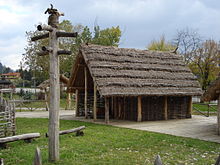
The shelter of the early people changed dramatically from the paleolithic to the neolithic era. In the paleolithic, people did not normally live in permanent constructions. In the neolithic, mud brick houses started appearing that were coated with plaster.[31] The growth of agriculture made permanent houses possible. Doorways were made on the roof, with ladders positioned both on the inside and outside of the houses.[31] The roof was supported by beams from the inside. The rough ground was covered by platforms, mats, and skins on which residents slept. [citation needed]
Farming

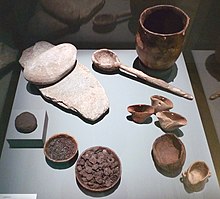
A significant and far-reaching shift in human subsistence and lifestyle was to be brought about in areas where crop farming and cultivation were first developed: the previous reliance on an essentially nomadic hunter-gatherer subsistence technique or pastoral transhumance was at first supplemented, and then increasingly replaced by, a reliance upon the foods produced from cultivated lands. These developments are also believed to have greatly encouraged the growth of settlements, since it may be supposed that the increased need to spend more time and labor in tending crop fields required more localized dwellings. This trend would continue into the Bronze Age, eventually giving rise to towns, and later cities and states whose larger populations could be sustained by the increased productivity from cultivated lands.
The profound differences in human interactions and subsistence methods associated with the onset of early agricultural practices in the Neolithic have been called the Neolithic Revolution, a term coined in the 1920s by the Australian archaeologist Vere Gordon Childe.
One potential benefit of the development and increasing sophistication of farming technology was the possibility of producing surplus crop yields, in other words, food supplies in excess of the immediate needs of the community. Surpluses could be stored for later use, or possibly traded for other necessities or luxuries. Agricultural life afforded securities that pastoral life could not, and sedentary farming populations grew faster than nomadic.
However, early farmers were also adversely affected in times of famine, such as may be caused by drought or pests. In instances where agriculture had become the predominant way of life, the sensitivity to these shortages could be particularly acute, affecting agrarian populations to an extent that otherwise may not have been routinely experienced by prior hunter-gatherer communities.[24] Nevertheless, agrarian communities generally proved successful, and their growth and the expansion of territory under cultivation continued.
Another significant change undergone by many of these newly-agrarian communities was one of diet. Pre-agrarian diets varied by region, season, available local plant and animal resources and degree of pastoralism and hunting. Post-agrarian diet was restricted to a limited package of successfully cultivated cereal grains, plants and to a variable extent domesticated animals and animal products. Supplementation of diet by hunting and gathering was to variable degrees precluded by the increase in population above the carrying capacity of the land and a high sedentary local population concentration. In some cultures, there would have been a significant shift toward increased starch and plant protein. The relative nutritional benefits and drawbacks of these dietary changes, and their overall impact on early societal development is still debated.
In addition, increased population density, decreased population mobility, increased continuous proximity to domesticated animals, and continuous occupation of comparatively population-dense sites would have altered sanitation needs and patterns of disease.
Technology

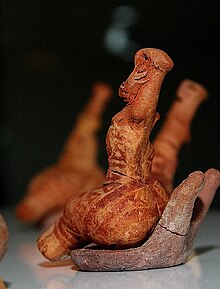
Neolithic peoples were skilled farmers, manufacturing a range of tools necessary for the tending, harvesting and processing of crops (such as sickle blades and grinding stones) and food production (e.g. pottery, bone implements). They were also skilled manufacturers of a range of other types of stone tools and ornaments, including projectile points, beads, and statuettes. But what allowed forest clearance on a large scale was the polished stone axe above all other tools. Together with the adze, fashioning wood for shelter, structures and canoes for example, this enabled them to exploit their newly-won farmland.
Neolithic peoples in the Levant, Anatolia, Syria, northern Mesopotamia and Central Asia were also accomplished builders, utilizing mud-brick to construct houses and villages. At Çatal höyük, houses were plastered and painted with elaborate scenes of humans and animals. In Europe, long houses built from wattle and daub were constructed. Elaborate tombs were built for the dead. These tombs are particularly numerous in Ireland, where there are many thousand still in existence. Neolithic people in the British Isles built long barrows and chamber tombs for their dead and causewayed camps, henges, flint mines and cursus monuments. It was also important to figure out ways of preserving food for future months, such as fashioning relatively airtight containers, and using substances like salt as preservatives.
The peoples of the Americas and the Pacific mostly retained the Neolithic level of tool technology until the time of European contact. Exceptions include few copper hatchets and spearheads in the Great Lakes region. However, there are numerous examples of development of complex socio-political organization, building technology, scientific knowledge and linguistic culture in these regions that parallel post-neolithic developments in Africa and Eurasia. Those include the Inca, Maya, ancient Hawaii, Aztec, Iroquois, Mississippian and Māori.
Clothing
Most clothing appears to have been made of animal skins, as indicated by finds of large numbers of bone and antler pins which are ideal for fastening leather, but not cloth. However, wool cloth and linen might have become available during the British Neolithic, as suggested by finds of perforated stones which (depending on size) may have served as spindle whorls or loom weights. The clothing worn in the Neolithic Age might be similar to that worn by Ötzi the Iceman, although he was not British and not Neolithic (since he belonged to the later Copper age).
Early settlements

Neolithic human settlements include:
- Tell Qaramel in Syria, 10,700–9400 BC
- Franchthi Cave in Greece, epipalaeolithic (c. 10,000 BC) settlement, reoccupied between 7500–6000 BC
- Lahuradewa in India, 9000 BC
- Göbekli Tepe in Turkey, c. 9000 BC
- Jericho in West bank, Neolithic from around 8350 BC, arising from the earlier Epipaleolithic Natufian culture
- Nevali Cori in Turkey, c. 8000 BC
- Ganj Dareh in Iran, c. 7000 BC

- Çatalhöyük in Turkey, 7500 BC
- Pengtoushan culture in China, 7500 – 6100 BC
- 'Ain Ghazal in Jordan, 7250–5000 BC
- Chogha Bonut in Iran, 7200 BC
- Jhusi in India, 7100 BC
- Karanovo in Bulgaria, 6200 BC
- Petnica in Serbia, 6000 BC
- Sesklo in Greece, 6850 BC (with a ±660 year margin of error)
- Dispilio in Greece, c. 5500 BC
- Padah-Lin Caves in Myanmar, c. 6000 BC
- Jiahu in China, 7000 to 5800 BC
- Mehrgarh in Pakistan, 7000 BC
- Knossus on Crete, c. 7000 BC
- Porodin in Republic of Macedonia, 6500 BC[32]
- Vrshnik (Anzabegovo) in Republic of Macedonia, 6500 BC[32]
- Pizzo di Bodi (Varese), Lombardy in Italy, c. 6320 ±80 BC
- Sammardenchia in Friuli, Italy , c. 6050 ±90 BC,
- Cucuteni-Trypillian culture, 5500–2750 BC, in Ukraine, Moldova and Romania first salt works
- Tabon Cave Complex in Quezon, Palawan, Philippines 5000 – 2000 BC [citation needed]
- Hemudu culture in China, 5000 – 4500 BC, large scale rice plantation
- around 2000 settlements of Trypillian culture, 5400 – 2800 BC
- The Megalithic Temples of Malta, 3600 BC
- Knap of Howar and Skara Brae, Orkney, Scotland, from 3500 BC and 3100 BC respectively
- Brú na Bóinne in Ireland, c. 3500 BC
- Lough Gur in Ireland from around 3000 BC
- Lajia in China, 2000 BC
The world's oldest known engineered roadway, the Sweet Track in England, dates from 3800 BC and the world's oldest free-standing structure is the neolithic temple of Ggantija in Gozo, Malta.
List of cultures and sites

Note: Dates are very approximate, and are only given for a rough estimate; consult each culture for specific pie time periods.
Mesolithic
Periodization: The Levant: 20,000 to 9500 BC; Europe: 9660 to 5000 BC; Elsewhere: 14,000 to 400 BC
- Azilian culture
- Balkan mesolithic cultures
- Capsian culture
- Fosna-Hensbacka culture
- Harifian culture
- Kebaran culture
- Jōmon cultures
- Jeulmun culture
- Komsa culture
- Kongemose culture
- Kunda culture
- Lepenski Vir culture
- Maglemosian culture
- Natufian culture
- Neman culture
- Nøstvet and Lihult cultures
- Sauveterrian culture
- Tardenoisian culture
- Zarzian culture
Early Neolithic
Periodization: The Levant: 10,000 to 8500 BC; Europe: 5000 to 4000 BC; Elsewhere: varies greatly, depending on region.
- Beixin culture
- Cishan culture
- Dudeşti culture
- Franchthi Cave people
- Earliest European Neolithic site: 20th to 3rd millennium BC
- Sesclo village culture
- Starcevo-Criş culture
- (also known as the Starčevo-Körös-Criş culture)
Middle Neolithic
Periodization: The Levant: 8500 to 6500 BC; Europe: 4000 to 3500 BC; Elsewhere: varies greatly, depending on region.
- Baodun culture
- Jinsha settlement and Sanxingdui mound.
- Cardium Pottery culture
- Comb Ceramic culture
- Corded Ware culture
- Cortaillod culture
- Cucuteni-Trypillian culture
- Dadiwan culture
- Dawenkou culture
- Daxi culture
- Grooved ware people
- Skara Brae, et al.
- Erlitou culture
- Ertebølle culture
- Hembury culture
- Hemudu culture
- Hongshan culture
- Houli culture
- Horgen culture
- Liangzhu culture
- Linear Pottery culture
- Longshan culture
- Majiabang culture
- Majiayao culture
- Peiligang culture
- Pengtoushan culture
- Pfyn culture
- Precucuteni culture
- Qujialing culture
- Shijiahe culture
- Trypillian culture
- Vinča culture
- Windmill Hill culture
- Xinglongwa culture
- Xinle culture
- Yangshao culture
- Zhaobaogou culture
Later Neolithic
Periodization: 6500 to 4500 BC; Europe: 3500 to 3000 BC; Elsewhere: varies greatly, depending on region.
Eneolithic
Periodization: Middle East: 4500 to 3300 BC; Europe: 3000 to 1700 BC; Elsewhere: varies greatly, depending on region. In the Americas, the Eneolithic ended as late as the 1800s for some people.
- Beaker culture
- Cucuteni-Trypillian culture
- Funnelbeaker culture
- Gaudo Culture
- Lengyel culture
- Varna culture
See also
|
Footnotes
- ^ a b c d e f Figure 3.3 from First Farmers: The Origins of Agricultural Societies by Peter Bellwood, 2004
- ^ Some archaeologists have long advocated replacing "Neolithic" with a more descriptive term, such as "Early Village Communities", although this has not gained wide acceptance.
- ^ a b c [1] Yet another sensational discovery by polish archaeologists in Syria
- ^ The potter's wheel was a later refinement that revolutionized the pottery industry.
- ^ Habu, Junko (2004). Ancient Jomon of Japan. Cambridge University Press. p. 3. ISBN 0521772133 (HB), ISBN 0521776708 (PB).
{{cite book}}: Check|isbn=value: invalid character (help) - ^ Japan Echo, Inc. (June 22, 1999). "Jomon Fantasy: Resketching Japan's Prehistory". Trends in Japan. Retrieved 2008-04-14.
- ^ Keally, Charles T. (2004). "'Fakery' at the Beginning, the Ending and the Middle of the Jomon Period". Bulletin of the International Jomon Culture Conference. 1. Archived from the original on 2008-03-16. Retrieved 2008-04-14.
- ^ "New Archaeological Discoveries and Researches in 2004 — The Fourth Archaeology Forum of CASS". Institute of Archaeology — Chinese Academy of Social Sciences. Retrieved 2007-09-18.
- ^ "The World's First Temple", Archaeology magazine, Nov/Dec 2008 p 23.
- ^ "Ancient Figs May Be First Cultivated Crops" by Christopher Joyce, NPR.org, last accessed 28 January 2009. [2]
- ^ "Jericho", Encyclopedia Britannica
- ^ Barker, Graeme The Agricultural Revolution in Prehistory: Why did Foragers become Farmers? OUP Oxford (22 January 2009) ISBN 978-0199559954 pp. 292–293 [3]
- ^ Aikhenvald, Alexandra Y; RMW Dixon Areal Diffusion and Genetic Inheritance: Problems in Comparative Linguistics p.35 [OUP Oxford (2 March 2006) ISBN 978-0199283088]
- ^ Hassan, Fekri Droughts, Food and Culture: Ecological Change and Food Security in Africa's Later Prehistory Springer (31 March 2002) ISBN 978-0306467554 pp.164 [4]
- ^ Shillington, Kevin Encyclopedia of African History Routledge; 1 edition (18 November 2004) ISBN 978-1579582456 p.521 [5]
- ^ Female figurine, circa 6000 BC, Nea Nikomidia, Macedonia, Veroia, (Archaeological Museum), Greece
- ^ Fuller, Dorian 2006. "Agricultural Origins and Frontiers in South Asia: A Working Synthesis" in Journal of World Prehistory 20, p.42 "Ganges Neolithic"
- ^ Tewari, Rakesh et al. 2006. "Second Preliminary Report of the excavations at Lahuradewa,District Sant Kabir Nagar, UP 2002–2003–2004 & 2005–06" in Pragdhara No. 16 "Electronic Version p.28"
- ^ Hirst, K. Kris. 2005. "Mehrgarh". Guide to Archaeology
- ^ a b Leonard D. Katz
Rigby (2000). Evolutionary Origins of Morality: Cross-disciplinary Perspectives. United kingdom: Imprint Academic. p. 352. ISBN 0719056128.
{{cite book}}: line feed character in|author=at position 16 (help) Page 158 - ^ Killen, pg 422.
- ^ "Stone Age," Microsoft Encarta Online Encyclopedia 2007 © 1997–2007 Microsoft Corporation. All Rights Reserved. Contributed by Kathy Schick, B.A., M.A., Ph.D. and Nicholas Toth, B.A., M.A., Ph.D. Archived 2009-11-01.
- ^ Guthrie, pg 420.
- ^ a b Bahn, Paul (1996) "The atlas of world archeology" Copyright 2000 The brown Reference Group plc
- ^ Idyllic Theory of Goddess Creates Storm
- ^ Krause (1998) under External links, places.
- ^ Orschiedt (2006) under External links, Places.
- ^ Guthrie, pg 422
- ^ Gimbutas (1991) page 143.
- ^ Ian Kuijt (2000) "Life in Neolithic Farming Communities: Social Organization, Identity, and differentiation" page 317 Springer press
- ^ a b Shane, Orrin C. III, and Mine Küçuk. "The World's First City." Archaeology 51.2 (1998): 43–47.
- ^ a b Developed Neolithic period, 5500 BC
Bibliography
- Bellwood, Peter (2004). First Farmers: The Origins of Agricultural Societies. Wiley-Blackwell. ISBN 0631205667.
- Pedersen, Hilthart (2008), "Die jüngere Steinzeit auf Bornholm", München & Ravensburg. ISBN 978-3638945592
External links
- McNamara, John (2005). "Neolithic Period". World Museum of Man. Retrieved 2008-04-14.
- Rincon, Paul (11 May 2006). "Brutal lives of Stone Age Britons". BBC News. Retrieved 2008-04-14.
- Vincha Neolithic Script
- UB Préhistoire — Enseignements sur le Néolithique
